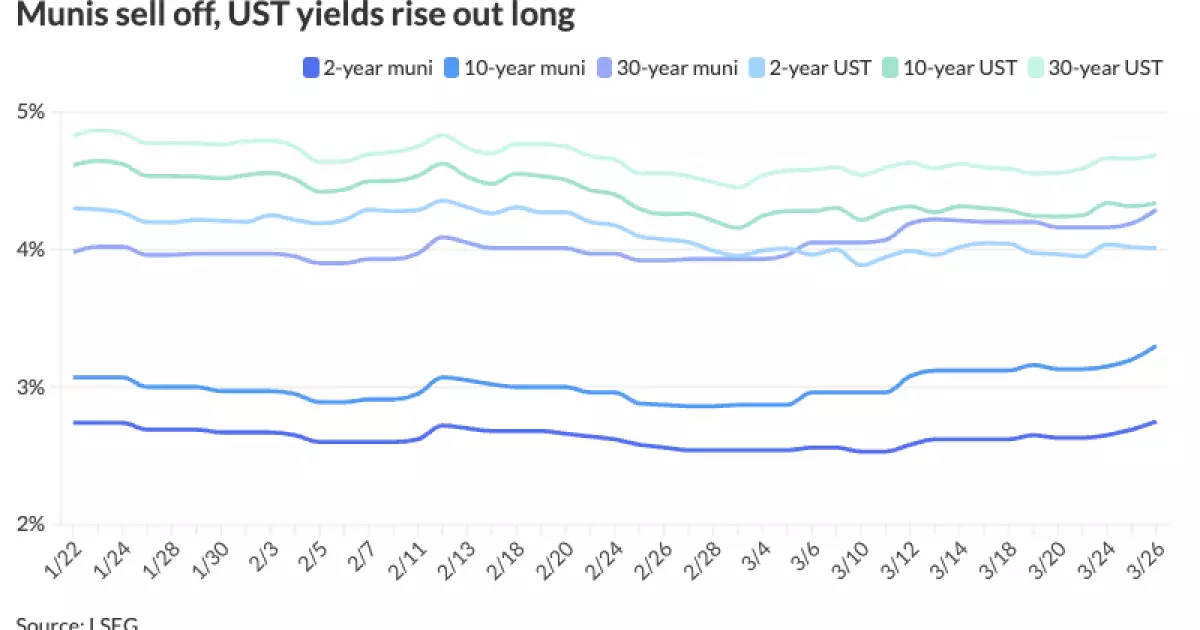Municipal markets stand at a precarious edge as fluctuations in yields reflect a broader unease choking liquidity. The reliance on municipal bonds to stabilize portfolios is becoming more questionable, given the recent double-digit cuts in yields during this tumultuous month. While the rise in U.S. Treasury yields signifies potential economic turmoil, municipal yields appear to be meandering along a turbulent path of their own. This inconsistency exposes a complex landscape fraught with uncertainty, revealing the intricate relationship between various financial instruments and the macroeconomic environment.
James Pruskowski, Chief Investment Officer at 16Rock Asset Management, categories the warm reception for alternative investments as artificially inflated by the winds of favorable primary supply. As we dive into these massive sales—such as the Board of Regents of the Texas A&M University System’s substantial refunding bond offering—we must consider what the data reveal about the appetite of investors. The expectation of month-end adjustments made by aggressive sellers has complicated a fragile market. These shifts ignite caution among buyers who feel caught in a whirlwind of competing economic signals, making decision-making arduous.
Contradictory Signals and Market Flows
Interestingly, conflicting signals are indicative of a market wrestling with its own identity crisis. The Investment Company Institute (ICI) reported scant inflows of $19 million for the week ending in March, especially in stark contrast to previous weeks that brought in an impressive $376 million. Interestingly, LSEG found over $216 million in outflows from muni mutual funds, heightening concerns over demand. Notably, exchange-traded funds experienced $306 million in inflows, suggesting a bifurcated response from investors.
While some seem eager to chase yields despite the risks, the hesitation among traditional mutual fund investors celebrates a more cautious mindset. Whether this divergence signals a turning point or simply reflects ongoing confusion about broader economic trends remains to be seen. As cautious optimism fights against visceral fear, many are left wondering whether this is merely a phase of capitulation leading to disillusionment.
Strained Liquidity and Aggressive Selling
Pruskowski lends credence to the idea that liquidity has never been more strained, underscoring the widening credit spreads that reflect a dire market imbalance. The liquidity panic is apparent, compelling many investors to assess their risk profiles as they sell off riskier positions—effectively tightening the noose on available capital for new projects or refinancing ventures. As the market transforms into a battlefield for finite resources, understanding the underlying cause of dislocation is vital for any investor trying to navigate through this storm.
This tactic of aggressively selling is perhaps the result of limited options in a marketplace that seems increasingly hostile toward new debentures. When the market for municipal bonds is healthy, the average trader can quickly absorb any new primary supply. However, as existing holders become increasingly fearful, the availability of capital shrinks, raising some tough questions about future financing possibilities. When emotional decision-making takes precedence over data-driven choices, the market inevitably faces heightened volatility.
Market Anticipation and Opportunities Amidst Uncertainty
Amidst the chaos, opportunities appear if investors browse carefully. The rhetoric surrounding caution spins into a tale of dislocation as “valuations are sticking out,” offering markers that theoretically present potential upside. Indeed, periods of uncertainty like these can breed unique opportunities. The resilience of municipal bonds could shine in a future restabilization, making it crucial to align oneself with the right positioning—especially as seasoned investors may find themselves squeezed tighter and searching for accurate spreads.
With municipal-UST ratios widening, a phenomenon that has been interpreted diversely, cautious investors have begun to talk quite excitedly about seizing upon marginal shifts. This dislocation may serve as a springboard for a more favorable investment climate down the road, prompting seasoned market participants to explore the riskier territories of municipal securities. The sentiment among many in the field oscillates between dread and anticipation, but one truth remains: economic recovery often abounds in the ashes of volatile markets.
In Search of Catalysts
Like many markets, the municipal bond sector searches for a clear catalyst – be it favorable tax regulations, positive employment data, or a geopolitical resolution that alleviates trade tensions. Investors should remain vigilant, for the current environment, however disheartening, often bodes well for the shrewdest players in the long run. As leaders and policymakers consider new fiscal measures, the outcomes could breathe new life into the delicate dynamics underpinning municipal fiscal structures.
In a setting dominated by macro risks such as tariff disputes and tax policy proposals, the presence of cash is encouraging, but the clear path forward remains infuriatingly murky. Real momentum in municipal markets may require a seismic shift—one that decentralizes current fears and allows liquidity to flow again. As we delve deeper into these financial complexities, market participants will want to strategize effectively amid the swelling uncertainties that shape the tides of municipal bonds.

